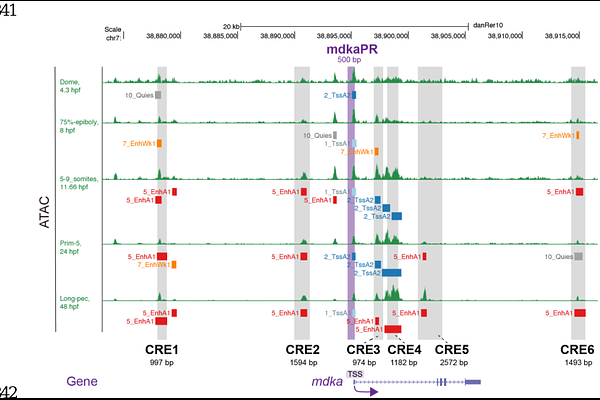Multiple cis-regulatory elements collaborate to control mdka expression in zebrafish adult telencephalic neural stem cells during constitutive and regenerative neurogenesis

Multiple cis-regulatory elements collaborate to control mdka expression in zebrafish adult telencephalic neural stem cells during constitutive and regenerative neurogenesis
Chen, J.; Hendriks, A.; Takamiya, M.; Beil, T.; Diotel, N.; Rastegar, S.
AbstractZebrafish is a powerful animal model for studying nervous system regeneration due to its remarkable regenerative abilities and the availability of diverse molecular tools. After telencephalic brain injury, neural stem cells (NSCs) in the ventricular zone (VZ) become activated, proliferate, and generate new neurons essential for brain repair. However, the molecular mechanisms regulating these processes remain unclear. Here, we investigate the transcriptional regulation of midkine-a (mdka), a heparin-binding growth factor gene encoding the secreted protein Midkine-a (Mdka), which is upregulated after injury in radial glial cells (RGCs), the bona fide NSCs of the adult zebrafish telencephalon. Using genome-wide bioinformatic analysis, we identified six putative cis-regulatory elements (CREs) associated with mdka. Transgenic assays showed that these CREs coordinate mdka expression during both development and regeneration. In the zebrafish embryo, CRE2, CRE3, CRE4, and CRE6 are required for EGFP expression in the nervous system, with CRE3 showing the strongest activity. In the adult telencephalon, CRE2, CRE4, and CRE6 are active in NSCs, with CRE2 best mimicking mdka expression in the ventricular zone. Importantly, individual CREs could not fully reproduce endogenous mdka expression, especially under regenerative conditions. In contrast, a combined CRE2/3/4/6 construct recapitulated mdka expression in both the embryo and adult telencephalon. These results suggest that mdka expression is controlled by a modular and cooperative cis-regulatory architecture that enables precise gene regulation during development, telencephalon homeostasis, and regeneration.